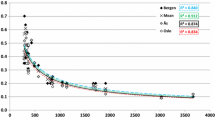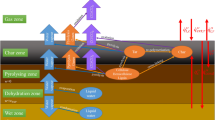Abstract
Performance based building (PBB) and design is closely connected to various needs and requirements: Performance levels need to be defined, test methods for verification of performance need to be developed, and reliable performance data are needed for materials, products, constructions, and different design solutions. In contrast to other building materials, PBB and thus service life prediction of timber and wood-based products requires particular consideration of wood-degrading organisms and their physiological needs. For the most relevant group of wood-destroying organisms, which are the different decay fungi and bacteria, wood moisture content and temperature need to be considered as key factors. This study aimed on the development of performance models on the basis of hard data obtained in field trials performed under most realistic conditions. Dose–response relationships, which can serve as essential parts of a performance based design model, were derived from material climatic data and corresponding decay development in the field. Different dose–response models are proposed and evaluated for predicting onset (and progress) of decay when wood is exposed to a dynamic and arbitrary climate exposure described in terms of time series of coupled temperature and moisture content. A logistic dose–response model was primarily focused on describing the relation between exposure and decay rating for moisture traps with long periods of high moisture contents. A two-step linear engineering model was more focused on predicting the behavior in a wider, more simplified, sense where periods of high moisture content are interrupted by periods of drier and/or colder climate.


















Similar content being viewed by others
References
Bakens W, Foliente G, Jasuja M (2005) Engaging stakeholders in performance based building: lessons from the Performance-Based Building (PeBBu) Network. Build Res Inf 33:149–158. doi:10.1080/0961321042000322609
Brischke, C, Frühwald Hansson, E, Kavurmaci, D, Thelandersson, S (2011) Decay hazard mapping for Europe. Document IRG/WP 11-20463. International Research Group on Wood Protection, Stockholm
Edlund M-L (2005) Principles for performance prediction: strategic considerations. COST E37, Oslo, Norway, 19th–21st June 2005
Hovde PJ, Moser K (2004) Performance based methods for service life prediction. State of the art reports, Part A & B, CIB Report
Lebow S, Woodward B, Lebow P, Clausen C (2008) The need for performance criteria in evaluating the durability of wood products. J Fac For Istanbul Univ Seri A Cilt 58 Sayi 2:29–41
Sjöström C, Caluwaerts P, Jernberg P, Haagenrud SE, Ilomäki A, Davies H (2005) Product declarations with respect to durability: a progress report. In: Proceedings of the 10th International Conference on Building Materials and Components, Lyon, France, 17–21 April 2005. TT5-128
MacKenzie CE, Wang C-H, Leicester RH, Foliente GC, Nguyen MN (2007) Timber service life design guide. Project report No. PN07.1052. Forest & Wood Products Australia Limited, Victoria
Wang C-H, Leicester RH, Nguyen MN (2008) Decay above ground. Manual No. 4. CSIRO Sustainable Ecosystems, Urban Systems Program, Highett, Victoria
Brischke C (2007) Investigation of decay influencing factors for service life prediction of exposed wooden components. Doctoral thesis, University of Hamburg, Hamburg
Van den Bulcke J, Van Acker J, de Smet J (2009) An experimental set-up for real-time continuous moisture measurements of plywood exposed to outdoor climate. Building and Environment 44:2368–2377. doi:10.1016/j.buildenv.2009.03.021
Gobakken LR, Lebow PK (2010) Modelling mould growth on coated modified and unmodified wood substrates exposed outdoors. Wood Sci Technol 44:315–333. doi:10.1007/s00226-009-0283-0
Van de Kuilen J-WG (2007) Service life modeling of timber structures. Mater Struct 40:151–161. doi:10.1617/s11527-006-9158-0
Kutnik M (2008) Assessment of the service life of outdoor timber constructions under various use conditions. In: Proceedings of COST E 37 Workshop: Enhanced durability focusing on differences in end-use related requirements, Heraklion, Greece, April 20–22, 2008
Thelandersson S, Isakson T, Ekstrand-Tobin A, Johansson P (2009) Modeling of onset of mould growth for wood exposed to varying climate conditions. Document IRG/WP 09-20414. International Research Group on Wood Protection, Stockholm
Viitanen H, Peuhkuri R, Ojanen T, Toratti T, Makkonen L (2008) Service life of wooden materials: mathematical modelling as a tool for evaluating the development of mould and decay. In: Van Acker J, Peek R-D (eds) Proceedings of the COST Action E 37 Final conference: Socio-economic perspectives of treated wood for the common European market, Bordeaux, September 29–30th 2008. Ghent University, Belgium, pp 97–106
Viitanen H, Toratti T, Peuhkuri R, Ojanen T, Makkonen L (2009) Evaluation of exposure conditions for wooden facades and decking. Document IRG/WP 09-20408. International Research Group on Wood Protection, Stockholm
Iwamae A, Suzuki H (2008) Durability of crawl space based on damage due to wood rot. In: Proceedings of 8th Symposium of Building Physics in the Nordic Countries, Copenhagen, June 16–18, pp 747–754
Lacasse MA, Manning M, Rousseau M, Cornick SM, Plescia S, Nicholls M, Nunes S (2007) Results on assessing the effectiveness of wall-window interface details to manage rainwater. In: 11th Canadian Conference on Building Science and Technology, Banff, Alberta, March 22–23, pp 1–14
Larkin GM, Laks PE (2008) To decay or not to decay: an accelerated field test of the validity of the Scheffer Index. Document IRG/WP 08-20392. International Research Group on Wood Protection, Stockholm
Lebow ST, Highley T (2008) Regional biodeterioration hazards in the United States. In: Schultz TP, Militz H, Freeman MH, Goodell B, Nicholas DD (eds) Development of commercial wood preservatives: efficacy, environmental, and health issues. ACS Symposium Series 982. American Chemical Society, Washington, DC, pp 120–141
Morris PI (2005) Service life prediction based on hard data. In: Proceedings of COST E 37 Workshop: Service life prediction: The contribution to Sustainability, Oslo, Norway, 19–21 June 2005
Wang J, Wu X, Jiang M, Morris PI (2007) Decay hazard classification in China for exterior above-ground wood. Document IRG/WP 07-20357. International Research Group on Wood Protection, Stockholm
Morris PI, McFarling S, Wang J (2008) A new decay hazard map for North America using the Scheffer Index. Document IRG/WP 08-10672. International Research Group on Wood Protection, Stockholm
European Committee for Standardization (1990) EN 252. Wood preservatives. Field test methods for determining the relative protective effectiveness in ground contact
Brischke C, Rapp AO (2010) Service life prediction of wooden components-Part 1: determination of dose response functions for above ground decay. Document IRG/WP 10-20439. International Research Group on Wood Protection, Stockholm
Thelandersson S, Isaksson T, Suttie E, Frühwald E, Toratti T, Grüll G, Viitanen H, Jermer J (2011a) Service life of wood in outdoor above ground applications: engineering design guideline. Background document. Report TVBK-3061, Div. of Structural Engineering, Lund University, Sweden
Schmidt O (2006) Wood and tree fungi. Biology, damage, protection, and use. Springer, Berlin
Arnold U (2009) Untersuchung zum kritischen Feuchte-Temperatur-Verhältnis für Pilzbefall an Holzbalkenköpfen. Master thesis, HAWK Hochschule für Angewandte Wissenschaft und Kunst, Fakultät Bauwesen, Hildesheim
Huckfeldt T, Schmidt O (2006) Hausfäule-und Bauholzpilze. Diagnose und Sanierung. Rudolf Müller, Köln
Isaksson T, Thelandersson S, Ekstrand-Tobin A, Johansson P (2010) Critical conditions for onset of mould growth under varying climate conditions. Build Environ 45:1712–1721. doi:10.1016/j.buildenv.2010.01.023
Viitanen H (1996) Factors affecting the development of mould and brown rot decay in wooden material and wooden structures. Department of Forest Products, The Swedish University of Agricultural Sciences, Uppsala, Sweden
Boddy L (1983) Effect of temperature and water potential on growth rate of wood-rotting basidiomycetes. Trans Br Mycol Soc 80:141–149. doi:10.1016/S0007-1536(83)80175-2
Griffin DM (1977) Water potential and wood-decay fungi. Ann Rev Phytopathol 15:319–329. doi:10.1146/annurev.py.15.090177.001535
Scheffer TC (1971) A climate index for estimating potential for decay in wood structures above ground. For Prod J 21:25–31
Setliff EC (1986) Wood decay hazard in Canada based on Scheffer’s climate index formula. For Chron 62:456–459. doi:10.5558/tfc62456-5
Hasegawa M (1996) Relationships between wood protection and climate indexes. Mokuzai Hozon 22:2–9
Francis LP, Norton J (2006) Predicting the decay resistance of timber above-ground. 1. Climate effects. Document IRG/WP 06-20330. International Research Group on Wood Protection, Stockholm
Brischke C, Welzbacher CR, Meyer L, Bornemann T, Larsson-Brelid P, Pilgård A, Frühwald Hansson E, Westin M, Rapp AO, Thelandersson S, Jermer J (2011) Service life prediction of wooden components-Part 3: approaching a comprehensive test methodology. Document IRG/WP 11-20464. International Research Group on Wood Protection, Stockholm
Frühwald Hansson E, Brischke C, Meyer L, Isaksson T, Thelandersson S, Kavurmaci D (2012) Durability of timber outdoor structures: modelling performance and climate impacts. In: World Conference on Timber Engineering 2012. Auckland, New Zealand, 16–19 July 2012
Viitanen H, Toratti T, Makkonen L, Peuhkuri R, Ojanen T, Ruokolainen L, Räisänen J (2010) Towards modeling of decay risk of wooden materials. Eur J Wood Wood Prod 68:303–313. doi:10.1007/s00107-010-0450-x
Thelandersson S, Isaksson T, Frühwald E, Toratti T, Viitanen H, Grüll G, Jermer J, Suttie E (eds) (2011b) Service life of wood in outdoor above ground applications. Report TVBK-3060, Div. of Structural Engineering, Lund University, Sweden
Acknowledgments
The present research is a part of the research programme WoodBuild co-ordinated by SP Technical Research Institute of Sweden. The research is financed by Vinnova, the Swedish Federation of Forest Industries and a number of companies in the forest and building sector.
Author information
Authors and Affiliations
Corresponding author
Rights and permissions
About this article
Cite this article
Isaksson, T., Brischke, C. & Thelandersson, S. Development of decay performance models for outdoor timber structures. Mater Struct 46, 1209–1225 (2013). https://doi.org/10.1617/s11527-012-9965-4
Received:
Accepted:
Published:
Issue Date:
DOI: https://doi.org/10.1617/s11527-012-9965-4




